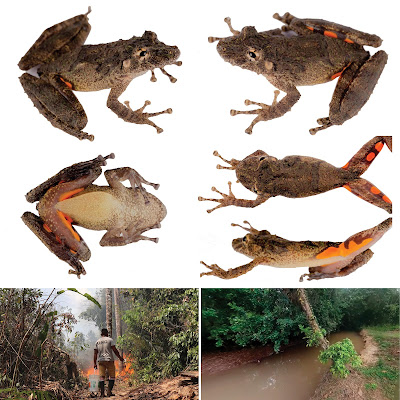Abstract
We describe a new species of tree frog from the middle Ucayali River, Peru. Scinax pyroinguinis sp. nov. is known from two males found in a patch of Amazon rainforest at 160 masl. Externally, the new species is similar to those in the Scinax rostratus group but it differs from all members by having a rounded head from dorsal view without proboscis or pointed tubercle on the tip of the snout, large conical tubercles on upper eyelids and heels, and bright orange blotches and spots on groins, posterior surface of thighs, and shanks. Genetic analysis supports our morphological study and confirms S. pyroinguinis sp nov as a new species, being tentatively the most basal member of the S. rostratus group. The new species is only known from the type locality that is currently threatened by habitat loss caused by wildfires.
Key Words: Amphibia, new species, Ucayali River, Scinax pyroinguinis, threatened, wildfires
 |
| Color pattern of the type series of Scinax pyroinguinis sp. nov. in life. A–D. Holotype (CORBIDI 24669, SVL = 42 mm); E–H. Paratopotype (CORBIDI 24700, SVL = 39.4 mm). |
 |
| A-B) Scinax pyroinguinis sp. nov., C-D) Scinax garbei, E-F) Scinax pedromedinae |
Scinax pyroinguinis sp. nov.
Diagnosis: A medium-sized species of Scinax; SVL of males 39.4–42.0 mm (n=2), females unknown; skin on dorsum tuberculate, tubercles large, spiculated; head rounded from dorsal and lateral view; nostrils protuberant, not projected from head contour in dorsal view; upper eyelid tubercles present, large, conical; tubercles on the lower jaw present, conical; vocal sac unpigmented; row of tarsal tubercles present; heel tubercle present, large, conical; row of ulnar tubercle present; a discrete anal flap present in males; a barely visible interorbital triangular mark pointed posteriorly; a large bright orange blotch on a dark background covering groin and anterior surface of thighs, bright orange spots on dark background covering posterior surface of thighs and shanks.
Etymology: The specific epithet pyroinguinis is an adjective that means “groins of fire”, and is formed from the combination of the Greek prefix “pyro” (=fire) and the Latin name “inguen” (=groin). The name refers to the striking orange blotched groins of the new species which remind us the flames of the wildfires threatening its habitat.
Germán Chávez, Wilmar Aznaran, Luis A. García-Ayachi and Alessandro Catenazzi. 2023. Rising from the Ashes: A New Treefrog (Anura, Hylidae, Scinax) from A Wildfire-threatened Area in the Amazon Lowlands of central Peru. Evolutionary Systematics. 7(1): 183-194. DOI: 10.3897/evolsyst.7.102425



